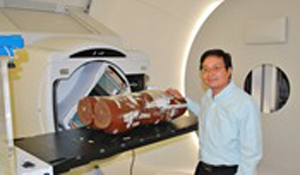Program Information
Determination of Field Parameters for Unflattened Photon Beams Using a Universal Scaling Factor
Y Chen1*, R Shih2, M Afghan2, A Gopal2, H Chen2, (1) Columbia University, New York, NY, (2) New York Presbyterian Hospital, New York, NY
SU-E-T-26 Sunday 3:00PM - 6:00PM Room: Exhibit HallPurpose: To investigate unflattened and flattened photon beam profiles and to propose a new method in determining field parameters for unflattened beams.
Methods: For flattened beams, field parameters of field size, etc., are defined according to the profile scaled the dose at central axis (D_CAX) to 100%. For unflattened beams, Siemens presents a table of scaling factors (to D_CAX) which are field size and energy dependent. The M. D. Anderson group presented a method to match the dose level at the inflection point for an unflattened beam to that for the corresponding flattened beam. By investigating cross-plane and in-plane profiles for the flat beams of Siemens Artiste 6 and 10 MV, Varian 21EX 6 and 10 MV, Trilogy 6 and 18 MV at different field sizes and depths, it was observed that the ratio of the dose at the inflection point (D_IP) to D_CAX remains unchanged within an uncertainty. Therefore, it is proposed to scale any unflattened beam profile by defining its D_IP to this value. After the scaling, the common definitions of field size, penumbra, and asymmetry remain the same.
Results: The ratio (D_IP/D_CAX) approaches a Gaussian distribution, yielding a mean of 54% with standard deviation of 2% for all data. The differences between the field sizes determined by this new method and those by Siemens scaling factors are mostly within 1 mm for Artiste 7 UF and 11 UF unflattened beams in a wide range of field sizes and depths. Varying this scaling factor in the 95% confidence interval leads to a variation within ±1 mm for field size determination.
Conclusion: This study demonstrates reasonability in use of single "54%" scaling factor to the inflection point for all unflattened beam profiles. The proposed method would provide simplification in determining field parameters for unflattened beams.
Funding Support, Disclosures, and Conflict of Interest: This work is supported in part by a Siemens research fund.
Contact Email:


